Having a base understanding of the speckled trout summer pattern is key if you want to have a shot at catching these fish.
Trust me, I understand that it's tough to spend all day on the water, become sunburned and dehydrated only to return to the dock empty-handed but see people cleaning a bunch of speckled trout you'd swear didn't exist!
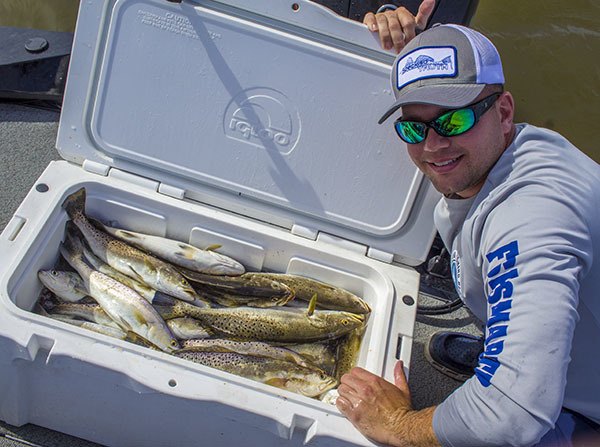
Don't you want to catch fish like this, too?
So how did they pull it off? Without a doubt, they possess that aforementioned base understanding of how speckled trout behave during the summer.
And, if you complete this guide, you'll possess that same understanding and change how and where you've been fishing. Let's take a closer look:
Speckled Trout Summer Pattern Broken Down "Barney Style"
Let's make this as easy as possible by breaking it down "Barney Style" so nothing is left out.
We are going to cover how the temperature affects speckled trout, their primary instinct during the summer, planning considerations and last, but not least, give some examples of places you ought to be fishing.
The Very First Thing You Must Understand About Speckled Trout
Speckled trout are a lot of things, and being creatures of comfort is one of them.
This means they set patterns, and their behavior becomes predictable.
When there is an external factor affecting a trout, you can count on him (or a slightly larger her) to respond a certain way.
You're No Different
People won't be outside during a blizzard, if they can help it. Instead, they will be inside where it is warm and safe.
If it's hot outside, they will do their best to stay cool by drinking cold water and hanging out in the shade.
If they can be inside an air conditioned room, then they will definitely be there.
Have outside work to do? Morning is a great time to do that, and noon is definitely the worst.
Here's the kicker: all of this holds true for speckled trout.
We Both Like Easy Food
Speckled trout are near-apex predators, but that does not mean that they are going to work any harder than they have to.
Nope, they will obtain their meals with the least amount of effort.
People are no different: they're not going to make eating any harder than what it has to be.
Argue what you will, but fast food chains have made billions using this concept.
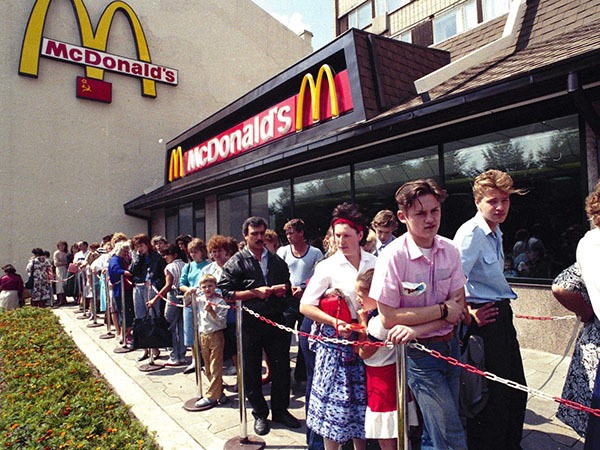
If speckled trout had a fast food option for shrimp and menhaden then you can bet they'd be standing in line, too.
Speckled trout will not spend anymore time looking for food when it's hot. They do this to such an extent that you can literally be casting at them and not get bit, during the hottest days of the summer.
We call these inactive fish, and it does happen. You don't want inactive fish, you want fish that are swimming around in a feeding frenzy.
So you finally understand that — just like you and me — 1.) speckled trout hate being hot and 2.) they enjoy an easy meal. Now that we've knocked that out, let's move on to the next big important thing dictating the speckled trout summer pattern.
The Speckled Trout Instinct To Spawn
Speckled trout are spawning during the summer. In fact, they spawn from about April to about September.
During the rest of the year it is not uncommon to find them in much fresher water right next to largemouth bass and blue catfish.
But this is not the case when they are spawning! When speckled trout need to spawn, the leave the lower salinity marsh for the relatively higher salinity outer bays.
They need the saltier water in order to successfully spawn.
Salinity is measured in ppt, or parts per thousand, and speckled trout need salinity of 17ppt or higher to spawn.
To put this into perspective, average strength seawater is 35ppt and freshwater is 0 to 0.5ppt.
The reason they need that saltier water, according to this white paper from Science Direct, is that their fertilized eggs will not survive:
"The ability to regulate the salinity of neutral buoyancy is especially important because eggs that are negatively buoyant will sink to the bottom and be buried in the sediment."
Yeah, whenever was being buried alive an option? Exactly.
But, in saltier water (around 17ppt, apparently) the eggs float as designed, into the marsh where they hatch, grow to maturity and the process begins all over again.
So, where is saltier water?
Towards the outside of the estuary, closer to the Gulf of Mexico.
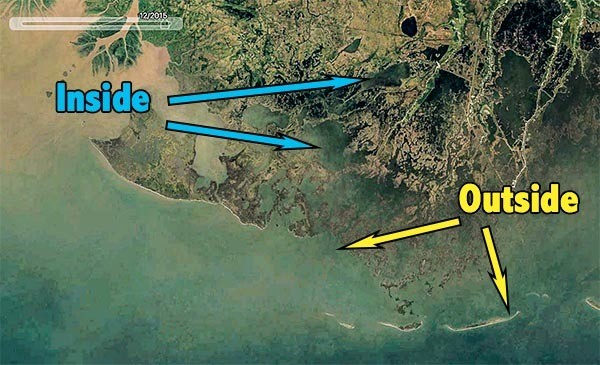
We definitely do not catch limits of speckled trout on the "inside" where it is less salty, even though we were catching them there in the fall, winter and spring. During summer we catch them on the "outside", as depicted above.
But this is only a generality!
Using Hydrocoast maps like the one pictured below helps you find water with the right salinity, so you may concentrate your efforts there.
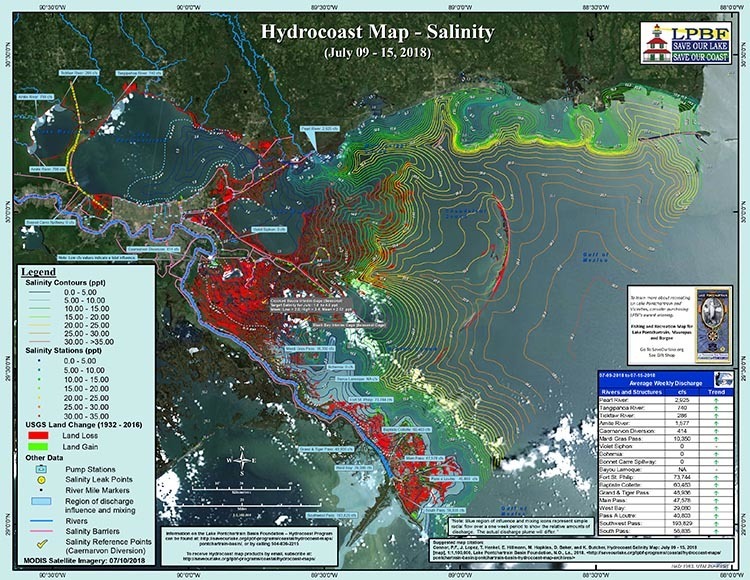
Quick Update on Hydrocoast Maps
Unfortunately, Hydrocoast maps are no longer created. They ran out of funding and have been discontinued, but the ones we do have still serve as a good model for how salinity spreads out in a gradient from the inside of the estuary toward the outside at the Gulf of Mexico.
With that said, we can use United States Geological Water Information System stations to check current salinity observations across Louisiana's coast.
Putting It All Together To Master The Speckled Trout Summer Pattern
So now we understand the broad brushstrokes of what we need to know in order to determine where and when to catch summertime specks:
With this in mind, it's easy to see what causes speckled trout to behave the way they do. What this when and where ultimately boils down to is fishing the outer sounds and bays first thing in the morning.
The Early Bird Gets The Worm
According to this article from LSU SeaGrant, speckled trout begin spawning en masse in the evening and are usually done by midnight.
Spawning is tough on these fish, causing them to burn a lot of energy. They get wore out and need to replenish.
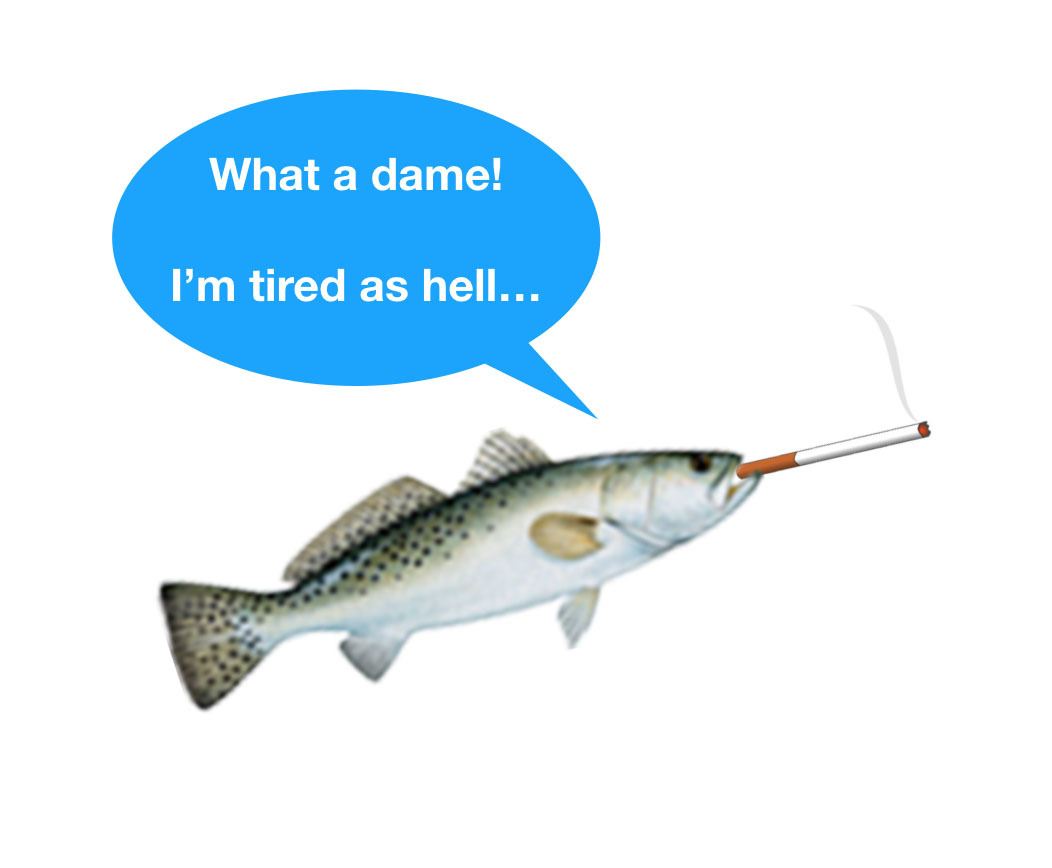
Because of this, the best time for them to grab a bite to eat are the hours before dawn and shortly thereafter. And not just because that's when they're not spawning, but also because that is when it's not so hot (like it would be at high noon).
And not just because it's cool in the morning, but also because that's when the bait will be active. Bait do not like being hot, either!
So, consider this: when you are fishing early in the morning, you are really catching the tail end of the bite.
The water temperature will rise with the sun and, once it does, you can depend on speckled trout to go deep and rest until it's time to spawn again.
Sure, you can still catch them here and there, but the best bet for a fast bite that will reach a limit is in the morning.
That's just the nature of the speckled trout summer pattern, and with that in mind I'd be at my first fishing spot before the sun cracks over the horizon.
Yes, this can have you running in the dark, so be sure you have your navigation lights, safe routes and GPS tracks in good order!
Once 9am rolls around the speckled trout bite is pretty much over, though it is possible to limit out on smaller trout until 11am, maybe noon.
So, if the morning is growing old and you still haven't found the fish, and if you know a good spot with smaller keeper-sized trout, then head straight there. Otherwise it's time to head in for an early start on clean-up!
Or, you can roll to Plan Redfish in an attempt to bail out the trip with a limit of those bronze-backed beauties.
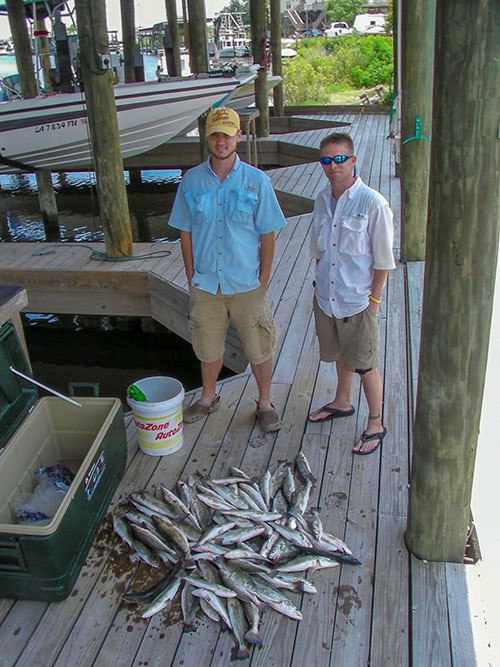
On this trip from June 2012 we didn't get on the trout right away. A move to a "small trout" spot after 10am helped us find these fish for 11am, where they caught their limit.
Or maybe you're feeling particularly adventurous and want to try something different, for which I suggest Plan Triple Tail.
I love a good afternoon searching for those floaty fish! This guide will get you pointed in the right direction, especially if you have no experience targeting them and have this fish on your bucket list.
Plan Triple Tail is always a good alternative when the speckled trout are being difficult.
Exceptions To The "9am Rule"
As always, there are exceptions in the speckled trout summer pattern, and the most obvious one is cloud cover.
With enough overcast weather, you can find a really good trout bite, like the one we found late in the day in this fishing trip.
To summarize: we got a late start and ended up finding the speckled trout relatively "late" in the day, around 1pm in the afternoon.
It wasn't hot, but the bite was, and we went from having zero speckled trout to catching our 3-man limit (75) in no time at all.
Think About Cloud Cover & Summertime Heat
The sun can't penetrate the water if clouds are in the way.
Strong overcast weather will keep water temperature from rising and create favorable light conditions for feeding.
I touch on this more in this article about why specks love overcast weather.
So, if you're out fishing for speckled trout during the summer and have a hard overcast sky, then you may want to consider sticking it out if you haven't found a good bite yet.
Even if you did find the speckled trout, that sure would be a good day to continue scouting for new spots, wouldn't it?
Some Examples of Places I Would Fish For the Speckled Trout Summer Pattern
Here, in the great state of Louisiana, where all roads are paved and free of potholes (ha, just kidding), I would fish in these locations for summertime specks:
I'm not saying "go fish those exact spots", but instead "look at these on a map" so that you have an idea as to what you're looking at.
These areas and spots tend to have the required salinity for speckled trout spawning, but also a lot of easy food that speckled trout enjoy, ranging from shrimp in the early summer months to finfish towards the end. You didn't think I was going to forget to tie that up, did you?
Anyway, they are certainly proven fishing spots, but you'd be naïve to run out there and start fishing without first having considered what's taught in this guide, especially that regarding salinity (because it does change).
In fact, this guide is only ~1,500 words, hardly what I would consider to be comprehensive or complete for everything you need to know to catch speckled trout and redfish year-round.
For that, I would consider Inshore Fishing 101, which is about 130,000 words (all video). Inshore Fishing 101 is found inside my membership, LAFB Elite, alongside a slew of other courses and learning aids.
Conclusion
The first step to catching any species is understanding their biology then, after that, the conditions on the day of your fishing trip.
- What primal urges do they have?
- What are the prevailing conditions?
- How does this affect where and when we fish?
That's what we covered in this guide, so now you have a more complete understanding of the speckled trout summer pattern but, if you'd like to learn more about where exactly to find speckled trout (and the various fishing spots of summer time to try first) then I strongly suggest enrolling in Summer Fish Location.
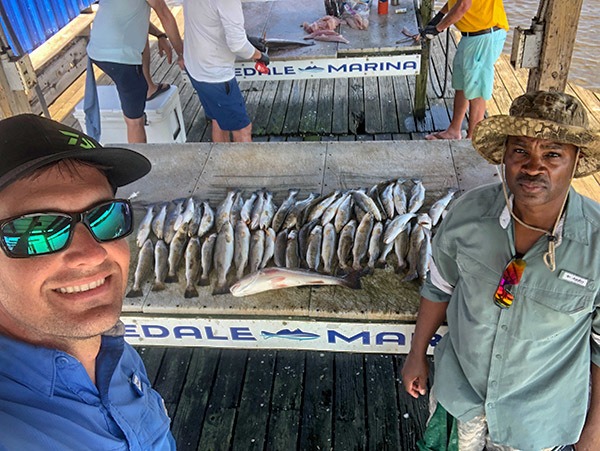
What Do You Think?
At the risk of sounding braggadocio, I'll say that I've done a pretty good job of successfully fishing the speckled trout summer pattern across Louisiana's coast.
I've had a great time catching specks from Slidell to Venice, from Port Sulphur to Cocodrie and even Vermilion Bay.
But those experiences have taught me that I don't know everything and — admittedly — is one reason I love inshore fishing so much: I keep learning!
That's also why I have the comments section on my blog, so that you — the esteemed reader — can chime in with your own thoughts and experiences.
If you have anything to share, then please do so below.
Thanks for reading, and tight lines!

Thanks for reading, Steve!
Great insight
thanks skipper
Yes, trout will follow the bait, up to a point. They do not do so absolutely.
For example, they don’t follow the white shrimp to the Gulf during the fall. Instead, they stay in the marsh.
After that, the leave shad and potbelly minnows to go spawn in saltier water. They will leave bait, what’s key is understanding why.
This is what I teach inside my courses.
As for falling tide, well, the tide doesn’t fall during the day every day of the year. So how do you assume people catch fish when the tide only falls at midnight? Does everybody only fish at night then?
No, speckled trout can be taught on falling and rising tides, it just depends on a litany of other factors that are too many to list here in this comment format.
I think there’s a lot of context you don’t have and would benefit from joining my membership to get it all in one spot (my video courses).
Thanks for reading, MJ!
Interesting article. I have read in other places that trout follow the bait which follow the tide flow and the very best time to fish is during a falling tide regardless of the time of day. Will you please comment?
Thank you for the kinds words, Johnny!
I love the article, it really shows water temp & salinity which both are very important when planing your trip. Devin, keep on sending this info. Every time I go over a class or blog a gain something new and we all know every edge counts. Thanks angain for the lesson. 🐠🐠🐠